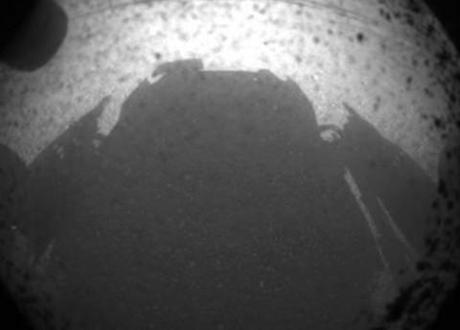 Mars rover Curiosity takes a picture of its own shadow, transmits back to earth., Photo credit: NASA/JPL-Caltech
Mars rover Curiosity takes a picture of its own shadow, transmits back to earth., Photo credit: NASA/JPL-Caltech
The background
Mars rover Curiosity, NASA’s mobile laboratory, landed safely on the red planet at 10:30 pm Pacific time – amid cheers and jubilation in the NASA Jet Propulsion Laboratory – and within two hours, began transmitting high-resolution images of its new home back to earth.
Curiosity will be on Mars for about 23 months – or the length of one Martian year.
So, what else do we know about NASA’s very famous and very expensive Mars explorer?
 The Mars Science Laboratory (MSL) team in the MSL Mission Support Area cheer after learning the the Curiosity rover has landed safely on Mars, Sunday, Aug. 5, 2012 in Pasadena, Calif. Photo credit: NASA/Bill Ingalls
The Mars Science Laboratory (MSL) team in the MSL Mission Support Area cheer after learning the the Curiosity rover has landed safely on Mars, Sunday, Aug. 5, 2012 in Pasadena, Calif. Photo credit: NASA/Bill Ingalls
Curiosity’s itinerary and mission
Curiosity left Earth on 26 November 2011, traveled 352 million miles (567 million kilometers) to reach Mars, where it will spend the next two years studying the terrain to discover whether the planet could ever have supported life. The $2.6 billion rover survived its “seven minutes of terror” descent onto the planet, an untried process involving the world’s largest supersonic parachute, and landed in Gale Crater, a 96-mile wide sunken bowl that may have once contained a lake. Next stop: Mount Sharp, a three-mile high mountain at the center of the crater, where the spacecraft will comb the soil for organic molecules, the building blocks of life.
Super space kit
Curiosity packs a lot of kit, specially designed to study Mars terrain, into a spacecraft the size of a small car: There are 17 cameras, including seven mounted on the craft’s “head”; it has a laser on its “forehead”, with which it can “zap” rocks from a distance to analyze the vapour to see whether they’re worth investigating; spectrometers, including the Alpha Particle X-Ray Spectrometer that can determine the abundance of chemical elements in rocks and soil; radiation detectors; environmental sensors; and atmospheric sensors. It has six wheels, mounted on a “rocker-bogie” carriage which enables it to withstand shocks and travel over Mars’s uncertain terrain, and it nuclear-powered.
Curiosity is not alone on Mars
Curiosity the US’s seventh and most expensive attempt at Mars exploration, and right now, it’s not alone on the red planet – Opportunity, launched from Earth in 2003, has been transmitting data since it landed in 2004. It’s been all over the place, despite becoming stuck in a Martian sand dune once, and has exceeded its expected lifetime of only 90 Martian days many, many times over.
Curiosity’s new home: Mars
Mars, named for the Roman god of war, appears red owing to the iron-rich dust that coats it; its gravity is 38 percent of Earth’s, meaning that you’ll weigh much less on Mars; and its atmosphere is mostly carbon dioxide with traces of nitrogen and argon – so not terribly breathable. Its surface, however, is covered with valleys and canyons, implying that it may have once supported water. That said, the Martian landscape is very different from Earth, in part due to the lack of plate tectonics.
Meet the guy who drives the rover
Curiosity is being controlled by scientists at NASA’s Jet Propulsion Laboratory, including 41-year-old Scott Maxwell, who is one of around a dozen people who get to “drive” the rover. Maxwell spoke with CNN about the responsibility: “”It’s a priceless national asset that happens to be sitting on the surface of another planet,” he said. “You better take that damn seriously.” Maxwell is tweeting about his experiences at @marsroverdriver.
Wow, I just saw I picked up a couple of *thousand* followers in the last day or so. Hi, guys! Um … <nervously tap-dances>
— Scott Maxwell (@marsroverdriver) August 6, 2012
Long distance call: How will the rover phone home?
Curiosity lands safely:
More in space
- Sally Ride dies
- ‘Oldest galaxy’ discovered
- Transit of Venus aids planet hunt

